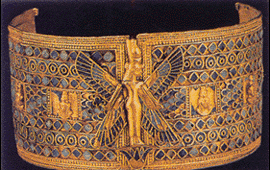 HISTORY HISTORY |

2500-1500 BC period of the Kerma civilisation
800-550 BC period of the Napata Kingdom
550 BC-350 AC Kingdom of Meroe; most of the archaeological sites date back to this period of time
600-1300 AC Christian Kingdom of the Northern Sudan
700-1400 AC immigration of many Arab tribes toward Sudan
1504 AC Kingdom of Sennar, during which period the Arab-Islamic culture took deep roots in the Sudan
1821 AC Conquer of the Sudan by the troops of Khedif Ismail
1881 AC Mahdist revolution by Mohamed Ahmed Al-Mahdi
1885-1898 AC Mahdist State
1898 AC invasion of the Sudan by Anglo-Egyptian army commanded by General Kitchener
1956 AC Independence of the Republic of the Sudan
 THE KINGDOM OF MEROE THE KINGDOM OF MEROE |

| A new period in the history of Nubia began with the transferral of the royal necropolis, which moved to just outside the royal residence in Meroe. The ancient kingdom of Kush came to an end and became the kingdom of Meroe. Although the god Amun did not disappear entirely from the scene, he lost his supreme position in the Nubian pantheon, to be replaced by Apedemak. This Nubian god of war and victory became the patron deity of the Meroitic state. He was represented as a man with a lion's head. New deities made their appearance, such as Sebiomeker, another form of the god Aton, creator of humankind. Certain ancient (Egyptian) gods remained popular, like Anubis who escorted the dead on their journey, and Isis the mother goddess who concerned herself with people's lives and fortunes. Indeed, in the Meroitic period, this goddess was mythologically wedded to the local god Apedemak.
A remarkably large number of reigning queens, known as Kandakes, is recorded in the history of Meroe. This forms a link with the matriarchal traditions of Africa and the high status accorded to women in Nubian culture. Already in the period of the Kushite Dynasty in Egypt, leading social positions, among them that of king, were passed down through the female line. Kings traced their lineage back through their mothers. The successor to a dead king would generally be the son of his sister. This explains why Napatan and Meroitic monarchs would often marry their own sisters so that their sons might succeed them. The king's mother, as mother of a god, held a position of enormous respect, somewhat comparable with that of Mary the mother of Christ, the son of a god in the Christian religion. The Meroitic queen-mother also bore the title of pharaoh. In some instances the queen mother would rule alongside her son if he were a minor, also jointly with her husband, and - remarkably enough sometimes independently. |

